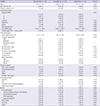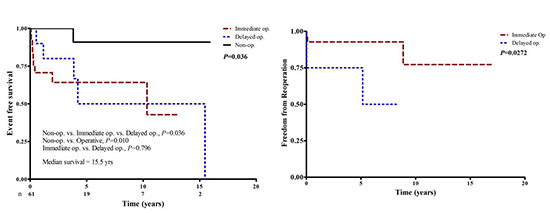1. Paranon S, Acar P. Ebstein’s anomaly of the tricuspid valve: from fetus to adult: congenital heart disease. Heart. 2008; 94:237–243.
2. Attenhofer Jost CH, Connolly HM, Dearani JA, Edwards WD, Danielson GK. Ebstein’s anomaly. Circulation. 2007; 115:277–285.
3. Yoon YE, Hong YJ, Kim HK, Kim JA, Na JO, Yang DH, Kim YJ, Choi EY. 2014 Korean guidelines for appropriate utilization of cardiovascular magnetic resonance imaging: a joint report of the Korean Society of Cardiology and the Korean Society of Radiology. Korean Circ J. 2014; 44:359–385.
4. Celermajer DS, Dodd SM, Greenwald SE, Wyse RK, Deanfield JE. Morbid anatomy in neonates with Ebstein’s anomaly of the tricuspid valve: pathophysiologic and clinical implications. J Am Coll Cardiol. 1992; 19:1049–1053.
5. Radford DJ, Graff RF, Neilson GH. Diagnosis and natural history of Ebstein’s anomaly. Br Heart J. 1985; 54:517–522.
6. Boston US, Goldberg SP, Ward KE, Overholt ED, Spentzas T, Chin TK, Knott-Craig CJ. Complete repair of Ebstein anomaly in neonates and young infants: a 16-year follow-up. J Thorac Cardiovasc Surg. 2011; 141:1163–1169.
7. Polimenakos AC, Reemtsen BL, Wells WJ, Starnes VA. Right ventricular exclusion procedure with total cavopulmonary connection: an alternative operative approach in adults with severe Ebstein anomaly. J Thorac Cardiovasc Surg. 2008; 135:1182–1183.
8. Dearani JA, Danielson GK. Surgical management of Ebstein’s anomaly in the adult. Semin Thorac Cardiovasc Surg. 2005; 17:148–154.
9. Badiu CC, Schreiber C, Hörer J, Ruzicka DJ, Wottke M, Cleuziou J, Krane M, Lange R. Early timing of surgical intervention in patients with Ebstein’s anomaly predicts superior long-term outcome. Eur J Cardiothorac Surg. 2010; 37:186–192.
10. Attenhofer Jost CH, Connolly HM, Scott CG, Burkhart HM, Warnes CA, Dearani JA. Outcome of cardiac surgery in patients 50 years of age or older with Ebstein anomaly: survival and functional improvement. J Am Coll Cardiol. 2012; 59:2101–2106.
11. Negoi RI, Ispas AT, Ghiorghiu I, Filipoiu F, Negoi I, Hostiuc M, Hostiuc S, Ginghina C. Complex Ebstein’s malformation: defining preoperative cardiac anatomy and function. J Card Surg. 2013; 28:70–81.
12. Bossone E, D’Andrea A, D’Alto M, Citro R, Argiento P, Ferrara F, Cittadini A, Rubenfire M, Naeije R. Echocardiography in pulmonary arterial hypertension: from diagnosis to prognosis. J Am Soc Echocardiogr. 2013; 26:1–14.
13. Grapsa J, Dawson D, Nihoyannopoulos P. Assessment of right ventricular structure and function in pulmonary hypertension. J Cardiovasc Ultrasound. 2011; 19:115–125.
14. Screaton N. The cardiothoracic ratio--an inaccurate and outdated measurement: new data from CT. Eur Radiol. 2010; 20:1597–1598.
15. Chon SB, Oh WS, Cho JH, Kim SS, Lee SJ. Calculation of the cardiothoracic ratio from portable anteroposterior chest radiography. J Korean Med Sci. 2011; 26:1446–1453.
16. Attie F, Rosas M, Rijlaarsdam M, Buendia A, Zabal C, Kuri J, Granados N. The adult patient with Ebstein anomaly. Outcome in 72 unoperated patients. Medicine (Baltimore). 2000; 79:27–36.
17. Roten L, Lukac PD, Groot N, Nielsen JC, Szili-Torok T, Jensen HK, Zimmermann M, Delacrétaz E. Catheter ablation of arrhythmias in Ebstein’s anomaly: a multicenter study. J Cardiovasc Electrophysiol. 2011; 22:1391–1396.
18. Silversides CK, Kiess M, Beauchesne L, Bradley T, Connelly M, Niwa K, Mulder B, Webb G, Colman J, Therrien J. Canadian Cardiovascular Society 2009 Consensus Conference on the management of adults with congenital heart disease: outflow tract obstruction, coarctation of the aorta, tetralogy of Fallot, Ebstein anomaly and Marfan’s syndrome. Can J Cardiol. 2010; 26:e80–97.
19. Warnes CA, Williams RG, Bashore TM, Child JS, Connolly HM, Dearani JA, del Nido P, Fasules JW, Graham TP Jr, Hijazi ZM, et al. ACC/AHA 2008 guidelines for the management of adults with congenital heart disease: a report of the American College of Cardiology/American Heart Association Task Force on practice guidelines (Writing Committee to develop guidelines on the management of adults with congenital heart disease). Developed in collaboration with the American Society of Echocardiography, Heart Rhythm Society, International Society for Adult Congenital Heart Disease, Society for Cardiovascular Angiography and Interventions, and Society of Thoracic Surgeons. J Am Coll Cardiol. 2008; 52:e143–263.
20. Gentles TL, Calder AL, Clarkson PM, Neutze JM. Predictors of long-term survival with Ebstein’s anomaly of the tricuspid valve. Am J Cardiol. 1992; 69:377–381.
21. Kapusta L, Eveleigh RM, Poulino SE, Rijlaarsdam ME, du Marchie Sarvaas GJ, Strengers JL, Delhaas T, de Korte CL, Feuth T, Helbing WA. Ebstein’s anomaly: factors associated with death in childhood and adolescence: a multi-centre, long-term study. Eur Heart J. 2007; 28:2661–2666.
22. Popelová J, Gebauer R, Pavel P, Cerný S, Jehlička P, Plášil P, Skalsky I. Operation of Ebstein anomaly in adulthood - our experience. Vnitr Lek. 2014; 60:335–340.







 PDF
PDF ePub
ePub Citation
Citation Print
Print




 XML Download
XML Download